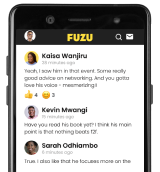In this 2-part series we take a look at 5 emerging HR trends. Find part one covering employer branding, employee experience and employee development.
Technology has kept its promise of changing the landscape of human capital management. The application of technology has made the workforce to be more agile and efficient. But how can HR ensure effective communication and productivity to keep up with the emerging HR trends?
Arnold Muoki, a renown HR expert, explains how employee feedback and flexible work schedule have evolved as aspects of employee engagement.
Technology has made the workplace more fluid which has subsequently led to increase of the number of organizations allowing for flexible work schedules. How does this affect employee retention, productivity?
The realities of the 21st century have presented the most challenging business environments in the history of business, one acronym that is synonymous with the present times is VUCA – Volatile, Uncertain, Complex and Ambiguous. However, the sophistication of this age is unforgiving, affecting organizations, employees, individuals and families alike, leaving no exception. Flexible work schedules have emerged as a response in finding the balance between the employers’ need to achieve consistent business outcomes with minimal interference from a demanding personal life of their employees.
History has shown that, if these competing interests are not amalgamated, the result is a workforce with conflict of interest, a disgruntled employer and a resultant negatively charged workplace with possible conflict at the home front. Flexible work schedules are of great benefit to the parent with a child who needs extra attention, an employee with evening classes and mid-week exams, an employee whose spouse has been promoted and has to relocate, a mother whose culture places the all domestic chores on her already heavy shoulders. All the above are employees whom without a flexible work schedule would have been conflicted, constantly having to question their priorities and who more often than not may contemplate to take actions that would put them at a point of disadvantage at work not excluding resignation.
In such situations, policies alone are not sufficient in managing such complex situations, an honest and humane approach needs to be adopted at the workplace. There is no situation that is like the other even those that seem to be the same.

How can HR provide support where flexible where schedules exist while still ensuring employee autonomy and career growth?
In work environments with flexible work cultures, HR can best thrive first and fore most as a mediator, managing between employees needs while ensuring that business outcomes are at best superseded and at the very least hardly affected and where the latter cannot be avoided propose solutions to mitigate the effects. In addition to the mediation role, HR ought to constantly monitor and evaluate the effectiveness of the program whilst engaging the stakeholders and engaging in feedback activities. Some of the tools available for monitoring are performance management, feedback surveys as well as employee and manager queries, complaints and suggestions.
What follows is the assessment of the contents which then can be interpreted to initiatives to improve the program by ensuring that such initiatives are fit for purpose. Another key involvement by the HR team is in benchmarking with other players both locally and internationally, observing practices by other organization is the fastest way to learn tried and tested approaches and compare pros and cons to determine best way to customize the practice to the work environment while contemplating adoption. This way the HR team will be an effective business partner to the business and an enabler of employee productivity and career growth.
It has been increasingly said that employee engagement makes employees feel valued and increases productivity. What are some of the best practices when it comes to implementing the culture of feedback in an organization?
As the world develops HR too has evolved and advanced in leap and bounds, notably is the size makeshift in its philosophy and practices towards people. With each phase through the last three decades the people centric with behavioral dynamics guiding most HR expert frontiers in developing people strategies that focus on improving employee value proposition and increased productivity. One such key dynamic is the need for conversation and feedback in strengthening of social bonds. It’s the most powerful, free yet one of the most underutilized leadership tools that organizations have today. Its importance lies in its ability to communicate expectation, indicate progress, motivate and it’s also a great tool for learning. If well positioned, some of the outcomes that feedback catalyzes are; sense of self-worth as individuals feel to be part of something, improves self- esteem hence increasing productivity, improves time management as individuals are guided to the best use of their time. In addition, people better deal with negative feedback in workplaces where feedback is positively managed. The inverse results in confusion, fear and insecurity in the workplace ultimately leading to low productivity and increasing employee attrition.
Amongst many, lets exploit some of the possible best practices in cultivating positive feedback in the workplace.
A) The outside – in approach, working system that puts the customer, their needs and input at the center of organizational strategy and operations. An example of a model that utilized this methodology is the agile way of working. It proposes a continuous engagement of all stakeholders throughout the production process to the delivery of the final product. The continuous interaction helps in managing expectations, giving accurate feedback on progress, improves collaboration, nurtures customer intimacy and overall customer experience and satisfaction once the product or service is delivered.
B) Employee involvement in strategy development - Contrary to old practices, the new school management practices find employees to be valuable contributors to strategy. This is owed largely to the fact that employees are closest to the action and intimately interact with customers. This validates their contribution/ input to strategy development as they are firsthand witnesses to experiences, outcomes and impact of the products and services to the customers and the community at large. In my view, the objectives and Key Results (OKRs) as opposed to Balance Score Card (BSC) and Management by Objectives (MBO) tops as the favorite in implementing this organizational collaboration in strategy development. Developed by Andy Grove in the 1970s and advanced by John Doerr, OKRs have gained popularity due to its traits of Nested cadence, which provides for organizational OKRs that are annual which are supported by quarterly set OKRs for departments and teams. This provides various teams with team specific objectives however, that support the organizational objectives, allowing them to pivot and align to their most pressing needs on a quarterly basis. However, there are mid quarter reviews to check on progress. OKRs have a clear line of the relationship between the set objectives, its key results, initiatives and weekly as well as daily activities. This complementary relationship between strategy and daily work operations has proven to have positive impact on employee productivity. The involvement of employees in developing their team OKRs improve engagement and ownership.
The rehabilitation of performance management practices pivoting from semiannual to annual backward looking programs that did postmortems taking stock of employee performance have been replaced with a more real time feedback and conversation performance program whose new philosophy is to increase interaction, grow employee support through mentorship and coaching with the aim of creating an enabling environment with continuous learning. With increased interaction, the more the opportunities for improving through organizational learning increasing accuracy, efficiency and innovative outcomes. This repositions managers to be facilitators, enabling employees to perform optimally. Its result being an engaged and motivated workforce.
C) Closer to the revamped performance management program is the customer service model to handling employee needs and welfare. The internal customer model bear roots from this view. This approach requires managers to grow their soft skills and better nurture their people skills. Its importance cannot be overemphasized and as mentioned earlier the leadership team has to act as a living example of what great customer service is to its employees. Its success relies on employee feedback which is achieved through the growth of the employee voice programs that has led to strategies such as employee representative programs and the works council programs. The development of the bottom – up communication channels create a sense of collaboration between management and employees, with their input employee motivation and ownership soars.
Lastly, the identification of interdependencies between strategies and organization systems has played a key role in their integrating. Strategy integration means that there is optimization of learnings from one strategy to another leading to a positive cause and effect relationship. For example, performance management outcomes, learning and development programs are developed which lead to improved work outcomes, career growth and development until the cycle is complete and stats all over again. The integration of organizational systems the physical and mental labor improving employee experience by reducing the administrative tasks of using various non complementary systems the employee is able analyze data through integrated reporting allowing them to do data comparison for better decision making. This improved feedback to the employee through integration is key in improving one’s work experience hence satisfaction.
Author

Arnold Muoki is a senior people capital and culture strategist. He holds a MSc. HRM, is a full member of IHRM and has a valid practicing license. He has an unwaivering desire to aligning organizational elements, improving their impact in the community as well as developing the capacity of youth through initiatives such as training, coaching, mentoring to prepare them for the job market.

